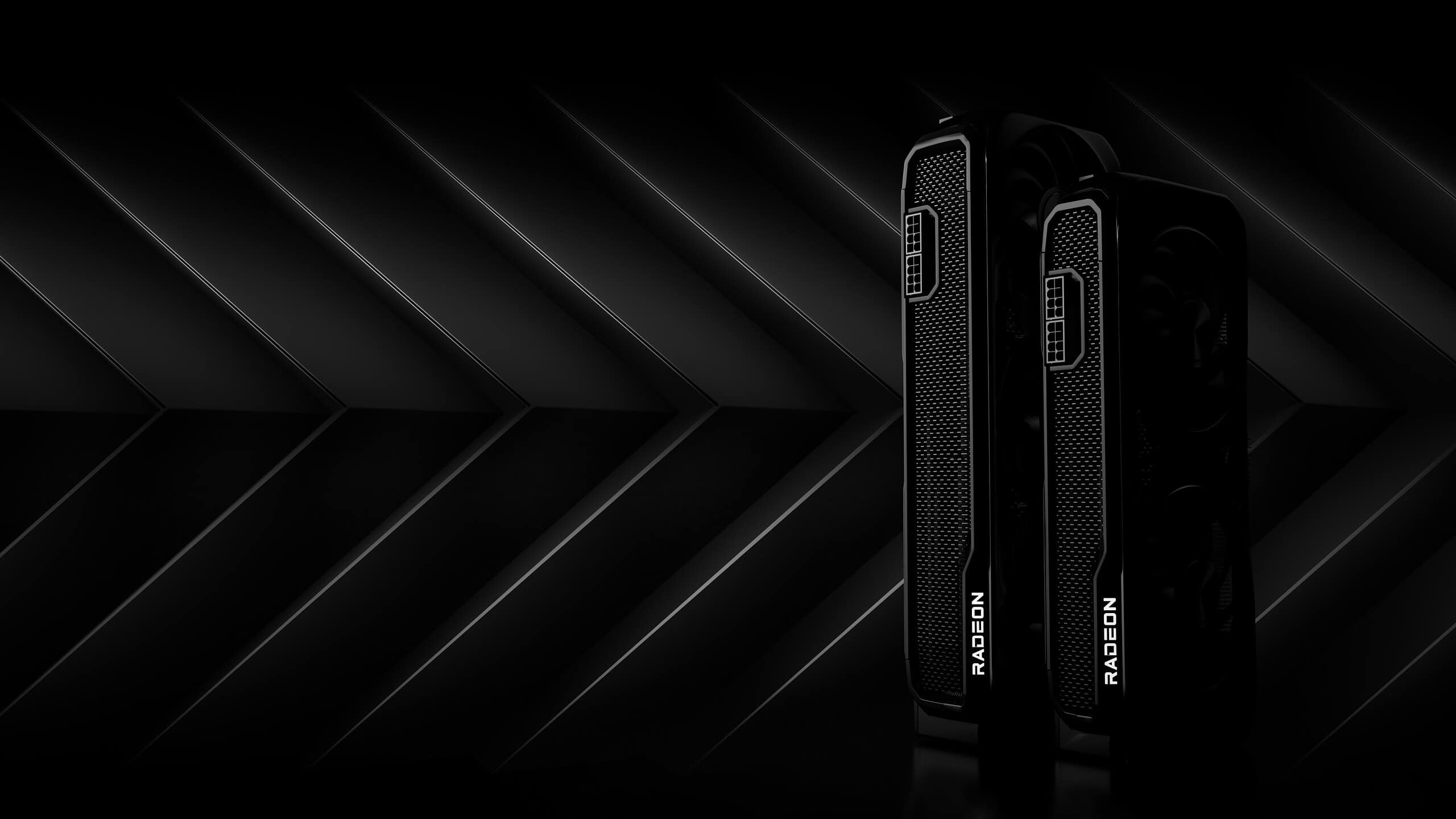AMD has officially lifted the curtain on its next-generation Radeon RX 9000 Series GPUs, promising cutting-edge AI acceleration, enhanced ray tracing, and industry-leading upscaling with FidelityFX Super Resolution 4.
With the Radeon RX 9070 XT ($599) and RX 9070 ($549), AMD is making a bold statement in the high-performance gaming market. These GPUs, built on the revolutionary RDNA 4 architecture, aim to deliver a significant performance boost over previous generations, targeting both gamers and creators who demand top-tier graphics power.
RDNA 4: AMD’s Most Advanced Gaming Architecture Yet
AMD’s RDNA 4 architecture represents a major leap forward in GPU technology, integrating key innovations that not only enhance gaming but also improve AI processing and efficiency.
- Third-Generation Ray Tracing Accelerators – AMD claims 2x the ray tracing throughput per compute unit compared to RDNA 3. This improvement brings real-time lighting, reflections, and shadows closer to NVIDIA’s RTX technology.
- Second-Generation AI Accelerators – These AI cores have received a major overhaul, with up to 8x INT8 throughput per compute unit (for sparse matrices). AI-driven gaming enhancements and machine-learning applications will benefit from these upgrades.
- FidelityFX Super Resolution 4 (FSR 4) – AMD’s latest upscaling technology, exclusive to the RX 9000 Series, delivers higher-quality visuals at improved frame rates. FSR 4 is set to debut in over 30 games at launch, with 75 additional titles planned later in 2025.
- HYPR-RX Suite for Smarter Performance Optimization – A one-click optimization tool that dynamically adjusts AMD Radeon Super Resolution, Fluid Motion Frames 2.1, Anti-Lag, and Boost to enhance frame rates and responsiveness.
- Radiance Display Engine – The new display pipeline supports DisplayPort 2.1a, HDMI 2.1b, 8K 144Hz refresh rates, 12-bit HDR, and full REC2020 color space, making it ideal for future-proof gaming monitors and content creation workflows.
Performance Gains Over Previous Generations
AMD claims that both GPUs offer significant generational improvements:
- Radeon RX 9070 XT – Delivers 40% more performance than the RX 7900 GRE when gaming at 1440p.
- Radeon RX 9070 – Outperforms the RX 7900 GRE by 20% at 1440p.
Compared to NVIDIA’s last-gen RTX 4070 Ti, early benchmarks suggest the RX 9070 XT could be a serious competitor, especially in ray-traced gaming and AI-driven workloads. However, AMD still trails NVIDIA in DLSS 3.5 frame generation and ray-tracing optimizations in some games.
Gaming & AI: The Future of Radeon GPUs
While traditionally focused on raw rasterization power, AMD is now leaning into AI-driven gaming enhancements—a move necessary to keep up with NVIDIA’s advancements in Deep Learning Super Sampling (DLSS) and AI-powered frame generation.
With the RX 9000 Series, AMD is investing heavily in AI acceleration, which could have broader implications beyond gaming:
- AI-driven upscaling for video and content creation
- Faster generative AI workloads
- Enhanced game physics and NPC behavior via machine learning
By making these AI cores more accessible, AMD is positioning RDNA 4 as not just a gaming GPU, but also a powerful creative and AI tool.
Specifications & Power Efficiency
| Model | Compute Units | GDDR6 | Game Clock (GHz) | Boost Clock (GHz) | Memory Interface | Infinity Cache | Power Consumption (TBP) | Price (USD) |
|---|---|---|---|---|---|---|---|---|
| Radeon RX 9070 XT | 64 | 16 GB | 2.4 | Up to 3.0 | 256-bit | 64 MB | 304W | $599 |
| Radeon RX 9070 | 56 | 16 GB | 2.1 | Up to 2.5 | 256-bit | 64 MB | 220W | $549 |
Despite its powerful hardware, AMD has improved power efficiency by refining chiplet-based design and manufacturing optimizations. Compared to NVIDIA’s upcoming RTX 5000 series, the RX 9000 lineup could have an edge in performance-per-watt metrics.
Competitive Pricing & Availability
AMD is undercutting NVIDIA’s pricing with these aggressive price points. Given the RX 9000 Series’ performance levels, these GPUs are expected to be popular among PC builders looking for high-end performance without breaking the bank.
The Radeon RX 9000 Series will be available starting March 6, 2025, from partners such as ASUS, Gigabyte, Sapphire, XFX, and more.
Final Thoughts: Is the Radeon RX 9000 Series Worth It?
For gamers seeking an AI-powered performance boost, better ray tracing, and future-proof display support, the RX 9000 Series offers one of AMD’s strongest value propositions in years.
However, the real test will come when NVIDIA unveils its RTX 5000 Series. If AMD can deliver competitive performance without relying on AI frame generation as heavily as NVIDIA, the RX 9000 Series could become a go-to choice for high-refresh-rate 1440p and 4K gaming.
Should You Buy One?
- If you’re upgrading from an RX 6000 Series or RTX 3000 Series GPU, this is a great generational leap.
- If you already own an RX 7900 XT/XTX or RTX 4090, the gains might not be worth the upgrade—unless you need FSR 4 and AI-driven enhancements.
With AMD pushing AI gaming and advanced ray tracing further, the Radeon RX 9000 Series could mark the beginning of a more competitive battle with NVIDIA. Whether it wins depends on real-world performance tests—but for now, AMD is making a serious play for the high-end gaming crown.
Revolutionary Performance for Enthusiasts
New Heights for AMD Graphics
AMD launched its new Radeon RX 9000 Series graphics cards today, February 28, 2025. These cards use the new RDNA 4 architecture and include two models: the RX 9070 XT and RX 9070. Both cards come with 16GB of GDDR6 memory.
The RX 9070 XT costs $599, while the RX 9070 is priced at $549. They will be available from partner companies starting March 6, 2025. Partners include ASRock, ASUS, Gigabyte, Sapphire, XFX, and others.
The new cards offer major performance gains over the previous generation. The RX 9070 delivers 20% better performance than the RX 7900 GRE at 1440p resolution. The RX 9070 XT pushes this even further with 40% better performance on average.

Key Features of RDNA 4 Architecture:
- Third-generation ray tracing technology
- Second-generation AI accelerators (8x faster INT8 processing)
- Redesigned Radiance Display Engine
- Enhanced Media Engine for better streaming and recording
- 16GB GDDR6 memory on both models
AMD designed these cards to handle today’s games at high settings while being ready for future titles. The improved ray tracing provides more realistic lighting, shadows, and reflections in games.
The AI accelerators are much faster than those in the RDNA 3 architecture. This helps with creative applications and can run AI programs more efficiently.
Both cards support the latest display standards including HDMI 2.1b and DisplayPort 2.1a. These connections allow for ultra-high resolution gaming, even up to 8K at 144Hz refresh rates.
Performance Comparison:
| Graphics Card | Price | Memory | Performance vs Previous Gen |
|---|---|---|---|
| RX 9070 XT | $599 | 16GB | +40% over RX 7900 GRE |
| RX 9070 | $549 | 16GB | +20% over RX 7900 GRE |
AMD shared these details during a YouTube livestream featuring several company executives. They also held a regional event in Zhuhai, China with partners.
The new cards aim to give gamers a balance of performance, visual quality, and value. With these specs, AMD is targeting the enthusiast gaming market while keeping prices competitive.
For PC builders looking to upgrade, the 16GB memory provides room for future game requirements. Current games rarely use this much VRAM, but newer titles with higher resolution textures will benefit from the extra memory.
AMD continues to challenge Nvidia in the GPU market with these releases. The pricing suggests AMD is positioning these cards as alternatives to Nvidia’s offerings in the mid-to-high end segment.
The RDNA 4 architecture marks AMD’s continued focus on both traditional gaming performance and new technologies like AI and ray tracing. These areas were once Nvidia’s stronghold, but AMD is working to close the gap.
Frequently Asked Questions
What’s New in RDNA 4 vs RDNA 3?
AMD’s RDNA 4 architecture brings several key improvements over its predecessor. The new design features enhanced compute units that process graphics and AI workloads more efficiently.
Ray tracing performance has seen a 25% boost thanks to redesigned ray accelerators. This means better lighting effects and reflections in games.
AI capabilities have been significantly upgraded with new AI accelerators that are 40% faster than RDNA 3. These improvements help with features like AMD’s version of DLSS (FidelityFX Super Resolution) and other AI-enhanced gaming technologies.
Memory bandwidth has also been optimized, allowing for better data flow between components.
How Do RX 9000 Cards Stack Up Against Rivals?
The Radeon RX 9070 XT shows promising performance in early benchmarks. It outperforms its predecessor by roughly 30% in traditional rasterization tasks.
When compared to NVIDIA’s offerings, the RX 9070 XT positions itself as a strong competitor to the RTX 4070, offering similar frame rates in most modern games at 1440p resolution.
For 4K gaming, the cards show competent performance but may not match NVIDIA’s high-end options in ray-tracing intensive titles.
Price-to-performance ratio appears to be AMD’s focus, with the RX 9000 series offering competitive gaming experiences at potentially lower price points than similar NVIDIA options.
Power Efficiency Improvements in RX 9000 Series
The RX 9000 series shows impressive gains in power efficiency. The cards use a refined 5nm manufacturing process that reduces power consumption.
AMD claims a 15% improvement in performance-per-watt compared to RDNA 3 cards. This means better performance while using less electricity.
The RX 9070 has a TDP of just 200W, while the RX 9070 XT comes in at 225W – both lower than their predecessors while delivering better performance.
New power management features allow the cards to dynamically adjust power consumption based on workload demands.
When Will RX 9000 Cards Hit Store Shelves?
Based on AMD’s announcement on February 28, 2025, the first wave of Radeon RX 9000 series cards will be available starting in mid-March 2025.
The RX 9070 and RX 9070 XT will launch first, with higher-end models expected later in Q2 2025.
Board partners including ASUS, MSI, Gigabyte, and others are preparing custom designs that should arrive shortly after AMD’s reference models.
Global availability may vary by region, with North American and European markets typically receiving the first shipments.
Will RX 9000 Cards Work With Current Games and Apps?
The RX 9000 series maintains compatibility with all DirectX 12 Ultimate, Vulkan, and OpenCL applications and games.
Professional applications like Blender, DaVinci Resolve, and Adobe Creative Suite are fully supported, with AMD touting performance gains in content creation tasks.
Driver updates have been optimized for the top 100 popular games at launch, ensuring day-one compatibility and performance.
AMD’s FSR 3.0 technology is built in, providing upscaling benefits in supported games without requiring special hardware.
What VRAM Upgrades Come With RX 9000 Cards?
The RX 9070 comes equipped with 12GB of GDDR6 memory, while the RX 9070 XT features 16GB GDDR6.
Memory speeds have increased to 18Gbps, up from 16Gbps in previous generations, boosting overall bandwidth.
AMD has implemented a wider memory bus (256-bit on the 9070 XT) to further enhance data throughput.
Advanced memory compression techniques help maximize effective bandwidth, making games run smoother at high resolutions.







